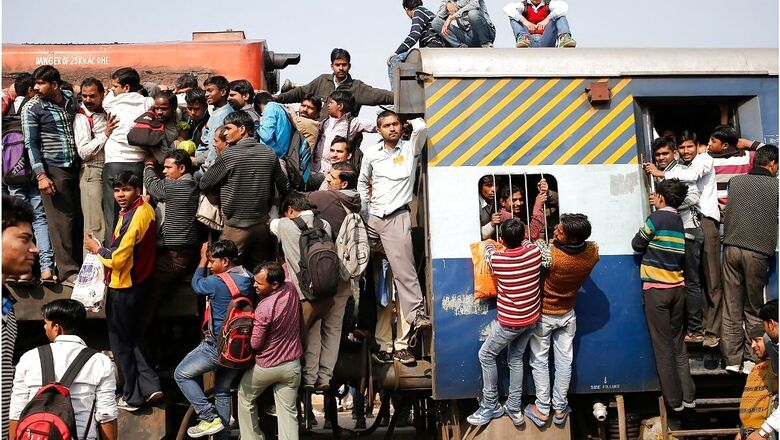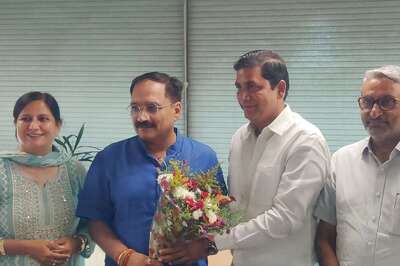
views
Nearly 7.9 billion people occupy 29.2 per cent of Earth’s total area. This comes to nearly 5 acre land per person if divided equally. India occupies 2.4 per cent of the total land area but supports over 18 per cent of the global population. Each person in India gets approximately 0.5 acres of land, and even this number is shrinking, leading to scarcity in resources and making survival difficult.
India’s population is seen as the biggest obstacle to its economic development. A country’s population should be its asset. India is still in the developing stage and controlling the growing population will help us build a more educated society. Only if per capita income increases and a family has enough to spend on a child’s education, we can see India grow and shine on the global stage.
In 1968, the Foreign Policy Association celebrated its 15th anniversary and invited thousands of scientists from around the world to a three-day conference to discuss how the world might look in 50 years’ time. After three days of discussion and suggestions from the scientists, a book “Toward the Year 2018” was published. A cursory reading of the book will tell us how we have ignored their suggestions, particularly on population.
Late theoretical physicist Stephen Hawking had warned against the perils of rapid increase in population and argued that humanity may eventually have to inhabit another planet to survive. In 2017, more than 15,000 scientists across 184 countries in a global statement flagged population growth as one of the gravest problems. Earlier in 1992, over 1,700 scientists had published a warning against population growth, among other negative trends that could put human survival at risk, immediately after the world population crossed the 5 billion-mark.
A Subject Never Debated in Parliament
Several parliamentarians over the years have risen above partisan politics and introduced private member bills on population control—40 such bills have been introduced in Parliament since Independence. Among them, Congress (16) leads the pack, followed by BJP (12), Telugu Desam Party (5), AIADMK (2) and one each from Trinamool Congress, Revolutionary Socialist Party, Samajwadi Party, Maharashtra Navnirman Sena and Rashtriya Janata Dal. However, it is unfortunate that such a serious subject has not been debated even once.
In 1992, then health and family welfare minister M.L. Fotedar had introduced The Constitution (Seventy-Ninth Amendment) Bill in the Rajya Sabha “to promote population control and the small family norm”, but it was not discussed in the Rajya Sabha.
ALSO READ | EXPLAINED: Why UP, Assam Think Two-Child Policy Will Help Check Population Growth
In 2018, Member of Parliament Sanjeev Balyan had submitted “The Responsible Parenthood Bill”—which I had drafted—as a private member bill in Lok Sabha. A total of 125 parliamentarians had written to then Lok Sabha Speaker Sumitra Mahajan for a discussion in the House on the pending private member bills on population control during the 2018 winter session. However, a time was not allotted to it.
In the recent past, whenever parliamentarians have asked questions related to population control, the government has always referred to the ICPD (International Conference on Population and Development), stating that India is bound by its rules and, therefore, it is not possible to bring any legislation for population control. In 2015, J.C. Diwakar Reddy and Parvesh Sahib Singh and in 2017, D.K. Suresh and Uday Pratap Singh received similar replies.
However, an examination of the ICPD manifesto reveals that if the government desires, it can adhere to the restrictions imposed by ICPD and still bring an India-specific law. Any country can adopt processes and legislation for population control and family planning measures as per their applicable legal provisions and culture.
The Indian government as well as all states have the power to pass legislation on population control and family planning as per point 20 A in the concurrent list of the 7th Schedule of the Constitution of India. This was included through the 42nd Constitutional Amendment 1976 and is effective since January 1, 1977.
In February 2000, then Prime Minister Atal Bihari Vajpayee constituted the National Commission to Review the Working of Constitution, headed by Justice Venkatachaliah. After two years of in-depth study, a report of 1979 pages was presented to then Law and Justice Minister Arun Jaitley in March 2002. The commission proposed a provision of small families for the purpose of population control, but it was never tabled in Parliament.
A Ticking Bomb
According to present data, some 2.40 crore babies are born every year in India whereas around 88 lakh people die each year. Simply put, the population is growing by 1.5 crore people per annum.
As per the 2011 Census, India had 33,96,21,277 married women and of them, 18,19,74,153 had two or fewer children. This indicates that despite family planning programmes—and the government spending an estimated Rs 2.5 lakh crore (present day value would be around Rs 25 lakh crore) on such initiatives since 1974—15,76,47,124 women still had more than two children.
Around 65 per cent of the population in India (or 90 crore people) is under 35 years of age. Even if India is successful in limiting the population growth to the global replacement rate (which is 2.1 live births per woman), an estimated 90 crore babies will be born over the next 35 years. It will not be an aberration to say that one can expect India to become a 2 billion-plus country in the next 35 years.
It is, therefore, imperative that we undertake special measures to control India’s population. A rapidly rising population causes social, economic and environmental imbalances in the country. Poverty, unemployment, pollution, adulteration, crimes etc. are on the rise as a result of the increasing population.
Social awareness campaigns are clearly not enough. They need to go hand-in-hand with clear and effective population control policies. Assam and Uttar Pradesh governments are moving in the right direction and they should be appreciated.
Read all the Latest News, Breaking News and Coronavirus News here.



















Comments
0 comment